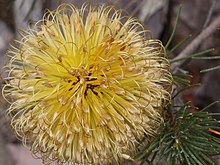Banksia sphaerocarpa
| Fox Banksia | |
|---|---|
 |
|
| Banksia sphaerocarpa var. sphaerocarpa at Stirling Range National Park | |
| Scientific classification | |
| Kingdom: | Plantae |
| (unranked): | Angiosperms |
| (unranked): | Eudicots |
| Order: | Proteales |
| Family: | Proteaceae |
| Genus: | Banksia |
| Species: | B. sphaerocarpa |
| Binomial name | |
|
Banksia sphaerocarpa R.Br. |
|
| Varieties | |
Banksia sphaerocarpa, commonly known as the Fox Banksia or Round-fruit Banksia, is a species of shrub or tree in the plant genus Banksia (family Proteaceae). It is generally encountered as a 1–2 m (3.3–6.6 ft) high shrub, and is usually smaller in the north of its range. This species has narrow green leaves, and brownish, orange or yellow round flower spikes which may be seen from January to July. It is widely distributed across the southwest of Western Australia, growing exclusively in sandy soils. It is usually the dominant plant in scrubland or low woodland. It is pollinated by, and is a food source for, birds, mammals, and insects.
First described in 1810 by botanist Robert Brown, B. sphaerocarpa has a complicated taxonomic history, and several taxa once classified as part of a broadly defined B. sphaerocarpa have since been named as species in their own right. At present, most authorities recognise five varieties; the largest variety, B. sphaerocarpa var. dolichostyla (Ironcap Banksia), is sometimes given species rank as B. dolichostyla. B. sphaerocarpa is classified as Not Threatened under the Wildlife Conservation Act of Western Australia, although two varieties have been placed on the Declared Rare and Priority Flora List—var. latifolia has been declared a Priority Two – Poorly Known taxon, and var. dolichostyla has been Declared Rare Flora. None of the varieties are commonly seen in cultivation.
Banksia sphaerocarpa is a variable species that differs in plant size, flower size and leaf size across its range. The variability is marked enough that five varieties are recognised. This species is generally a shrub 0.4–2 m (1.3–6.6 ft) tall. Plants are smaller in northern parts of the range, and grow larger in the southeast, with var. dolichostyla and rarely var. caesia reaching 4 m (13 ft) in height. All varieties bear a lignotuber, a swollen starchy root crown from which the plant resprouts after bushfire. The new stems are finely hairy but become smooth with maturity. The leaves are stiff, narrow and linear, and measure 2.5–10 cm (0.98–3.94 in) in length, on a petiole 2–3 mm (0.079–0.118 in) long. Leaves of most varieties are 1–1.5 mm in width, and have a pointed tip, but var. latifolia has wider leaves, 2–2.5 cm (0.79–0.98 in), and a blunter tip. The foliage is green, or a more pale blue-grey in the case of caesia and dolichostyla.
...
Wikipedia
